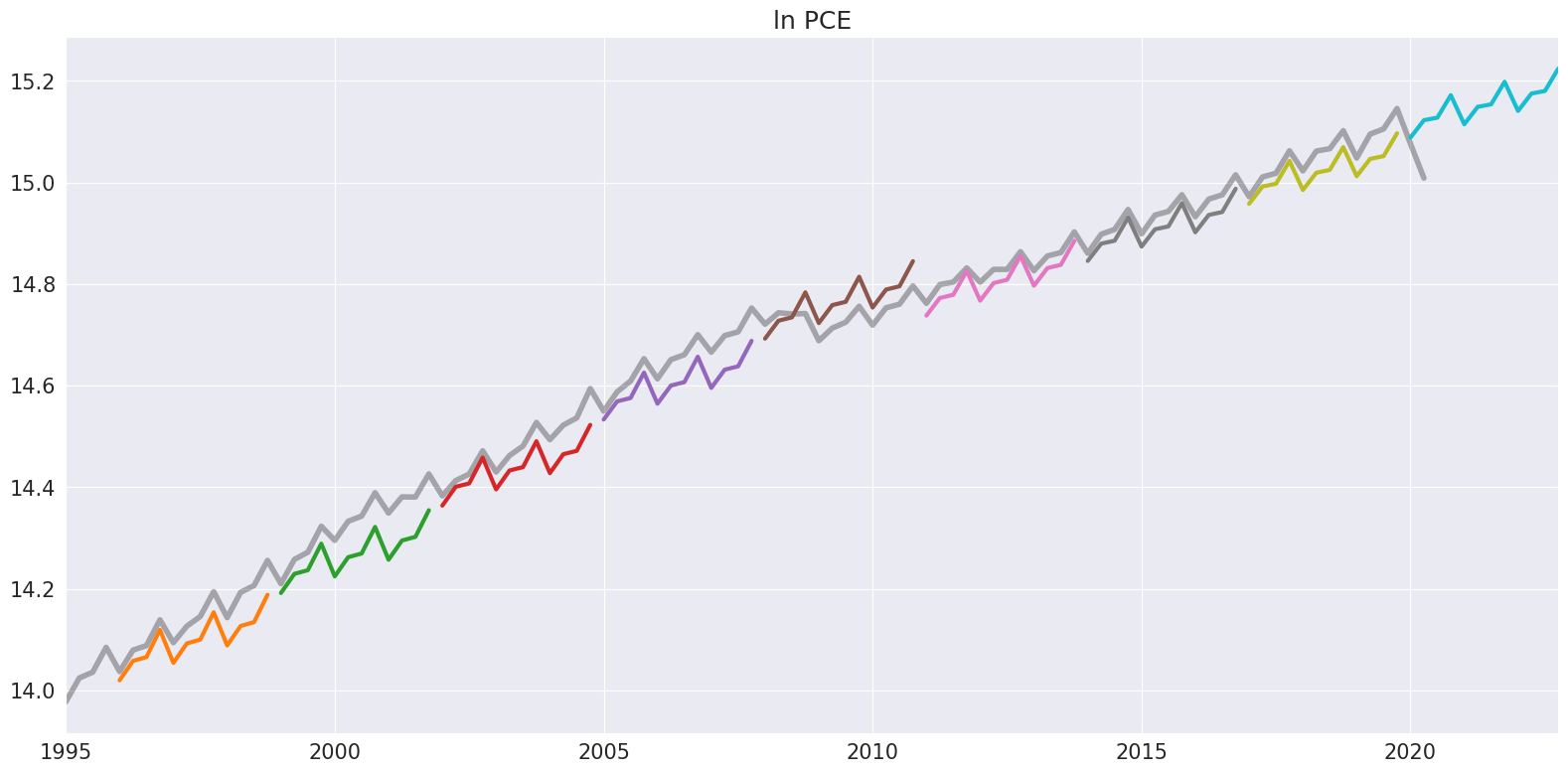Theta 模型¶
Assimakopoulos & Nikolopoulos (2000) 的 Theta 模型是一种简单的预测方法,它涉及拟合两条 \(\theta\) 线,使用简单指数平滑法预测这些线,然后将来自这两条线的预测结合起来以产生最终预测。该模型按以下步骤实现
测试季节性
如果检测到季节性,则进行季节性调整
通过将 SES 模型拟合到数据来估计 \(\alpha\),并通过 OLS 估计 \(b_0\)。
预测序列
如果数据已进行季节性调整,则重新进行季节性调整。
季节性测试检查季节性滞后 \(m\) 处的 ACF。如果该滞后明显不同于零,则使用 statsmodels.tsa.seasonal_decompose 对数据进行季节性调整,使用乘法方法(默认)或加法方法。
模型的参数是 \(b_0\) 和 \(\alpha\),其中 \(b_0\) 是从 OLS 回归中估计的
而 \(\alpha\) 是 SES 平滑参数,在以下公式中
然后预测值为
最终,\(\theta\) 只在决定趋势的衰减程度方面发挥作用。如果 \(\theta\) 非常大,则该模型的预测与带有漂移的积分移动平均预测相同,
最后,如果需要,对预测进行重新季节性调整。
该模块基于
Assimakopoulos, V., & Nikolopoulos, K. (2000). The theta model: a decomposition approach to forecasting. International journal of forecasting, 16(4), 521-530.
Hyndman, R. J., & Billah, B. (2003). Unmasking the Theta method. International Journal of Forecasting, 19(2), 287-290.
Fioruci, J. A., Pellegrini, T. R., Louzada, F., & Petropoulos, F. (2015). The optimized theta method. arXiv preprint arXiv:1503.03529.
导入¶
我们从标准的导入集开始,并对默认的 matplotlib 样式进行一些调整。
[1]:
import matplotlib.pyplot as plt
import numpy as np
import pandas as pd
import pandas_datareader as pdr
import seaborn as sns
plt.rc("figure", figsize=(16, 8))
plt.rc("font", size=15)
plt.rc("lines", linewidth=3)
sns.set_style("darkgrid")
加载一些数据¶
我们首先查看使用美国数据的房屋开工数据。该系列显然是季节性的,但在同一时期没有明显的趋势。
[2]:
reader = pdr.fred.FredReader(["HOUST"], start="1980-01-01", end="2020-04-01")
data = reader.read()
housing = data.HOUST
housing.index.freq = housing.index.inferred_freq
ax = housing.plot()
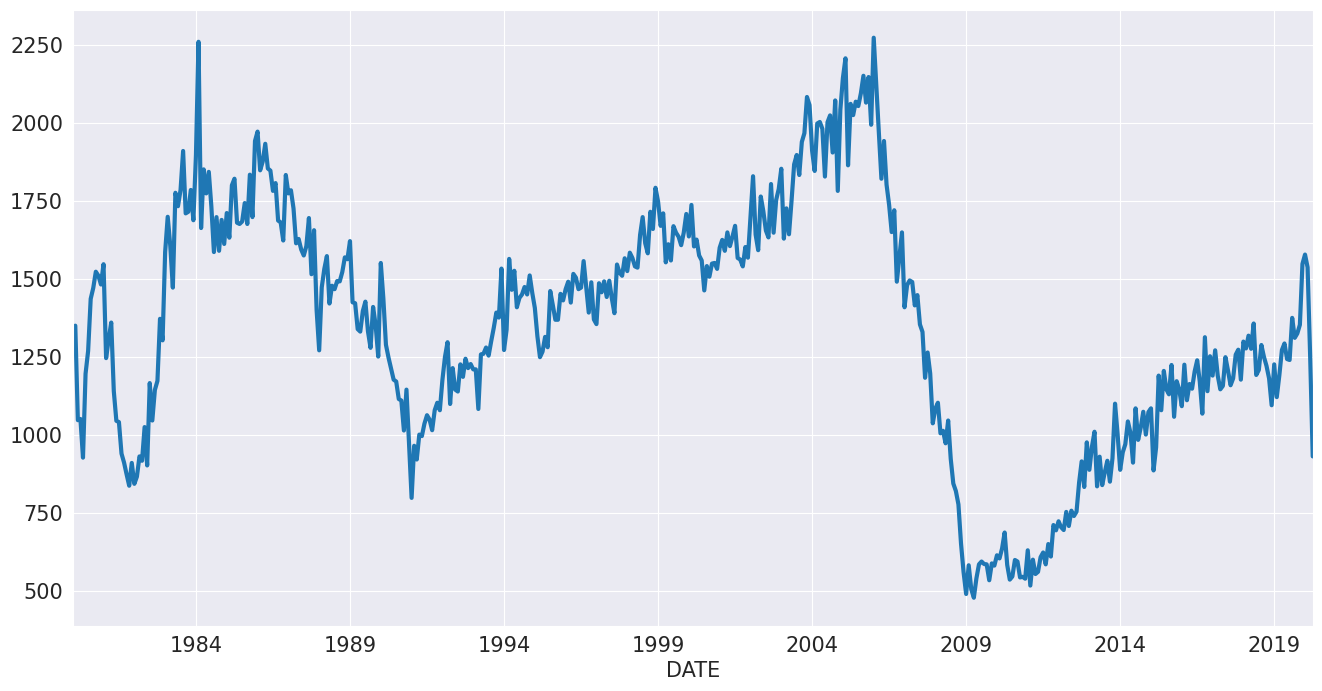
我们拟合指定模型,没有任何选项并进行拟合。摘要显示数据使用乘法方法进行了季节性调整。漂移适度且为负,平滑参数相当低。
[3]:
from statsmodels.tsa.forecasting.theta import ThetaModel
tm = ThetaModel(housing)
res = tm.fit()
print(res.summary())
ThetaModel Results
==============================================================================
Dep. Variable: HOUST No. Observations: 484
Method: OLS/SES Deseasonalized: True
Date: Thu, 03 Oct 2024 Deseas. Method: Multiplicative
Time: 15:46:28 Period: 12
Sample: 01-01-1980
- 04-01-2020
Parameter Estimates
=========================
Parameters
-------------------------
b0 -0.9194460961668147
alpha 0.616996789006705
-------------------------
该模型首先也是一个预测方法。使用拟合模型中的 forecast 方法生成预测。下面,我们通过每 2 年预测 2 年的预测值生成刺猬图。
注意:默认的 \(\theta\) 为 2。
[4]:
forecasts = {"housing": housing}
for year in range(1995, 2020, 2):
sub = housing[: str(year)]
res = ThetaModel(sub).fit()
fcast = res.forecast(24)
forecasts[str(year)] = fcast
forecasts = pd.DataFrame(forecasts)
ax = forecasts["1995":].plot(legend=False)
children = ax.get_children()
children[0].set_linewidth(4)
children[0].set_alpha(0.3)
children[0].set_color("#000000")
ax.set_title("Housing Starts")
plt.tight_layout(pad=1.0)
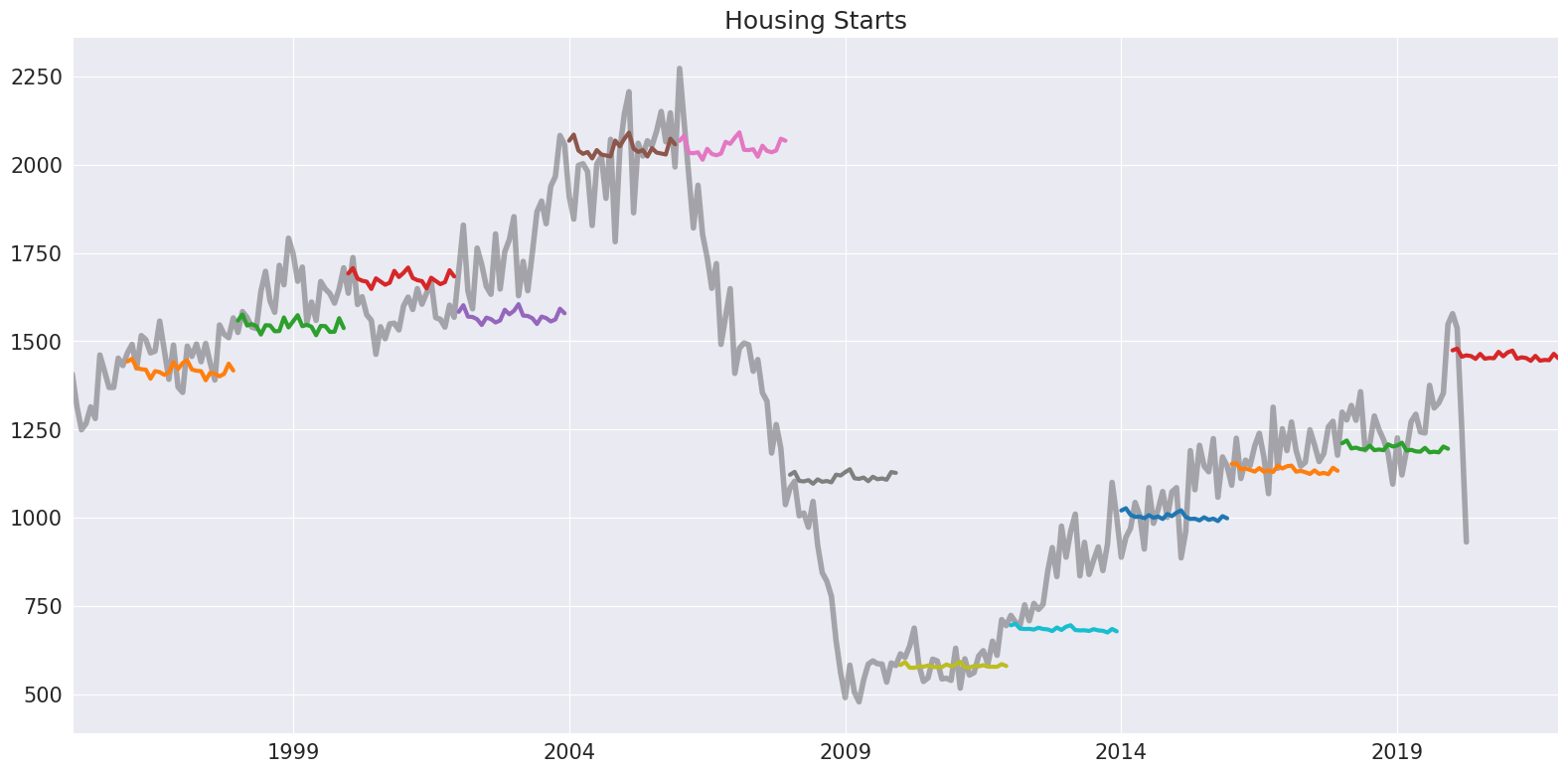
或者,我们可以拟合数据的对数。在这里,强制季节性调整使用加法方法更有意义,如果需要。我们还使用 MLE 拟合模型参数。该方法拟合 IMA
其中 \(\hat{\alpha}\) = \(\min(\hat{\gamma}+1, 0.9998)\),使用 statsmodels.tsa.SARIMAX。参数相似,尽管漂移更接近于零。
[5]:
tm = ThetaModel(np.log(housing), method="additive")
res = tm.fit(use_mle=True)
print(res.summary())
ThetaModel Results
==============================================================================
Dep. Variable: HOUST No. Observations: 484
Method: MLE Deseasonalized: True
Date: Thu, 03 Oct 2024 Deseas. Method: Additive
Time: 15:46:30 Period: 12
Sample: 01-01-1980
- 04-01-2020
Parameter Estimates
=============================
Parameters
-----------------------------
b0 -0.00044644118691643226
alpha 0.670610385005854
-----------------------------
预测仅取决于预测趋势分量,
SES 的预测(不会随着预测范围的改变而改变),以及季节性因素。这三个分量可以使用 forecast_components 获得。这允许使用上面权重表达式构建使用多个 \(\theta\) 选择的预测。
[6]:
res.forecast_components(12)
[6]:
| 趋势 | ses | 季节性 | |
|---|---|---|---|
| 2020-05-01 | -0.000666 | 6.95726 | -0.001252 |
| 2020-06-01 | -0.001112 | 6.95726 | -0.006891 |
| 2020-07-01 | -0.001559 | 6.95726 | 0.002992 |
| 2020-08-01 | -0.002005 | 6.95726 | -0.003817 |
| 2020-09-01 | -0.002451 | 6.95726 | -0.003902 |
| 2020-10-01 | -0.002898 | 6.95726 | -0.003981 |
| 2020-11-01 | -0.003344 | 6.95726 | 0.008536 |
| 2020-12-01 | -0.003791 | 6.95726 | -0.000714 |
| 2021-01-01 | -0.004237 | 6.95726 | 0.005239 |
| 2021-02-01 | -0.004684 | 6.95726 | 0.009943 |
| 2021-03-01 | -0.005130 | 6.95726 | -0.004535 |
| 2021-04-01 | -0.005577 | 6.95726 | -0.001619 |
个人消费支出¶
接下来,我们查看个人消费支出。该系列具有明显的季节性分量和漂移。
[7]:
reader = pdr.fred.FredReader(["NA000349Q"], start="1980-01-01", end="2020-04-01")
pce = reader.read()
pce.columns = ["PCE"]
pce.index.freq = "QS-OCT"
_ = pce.plot()
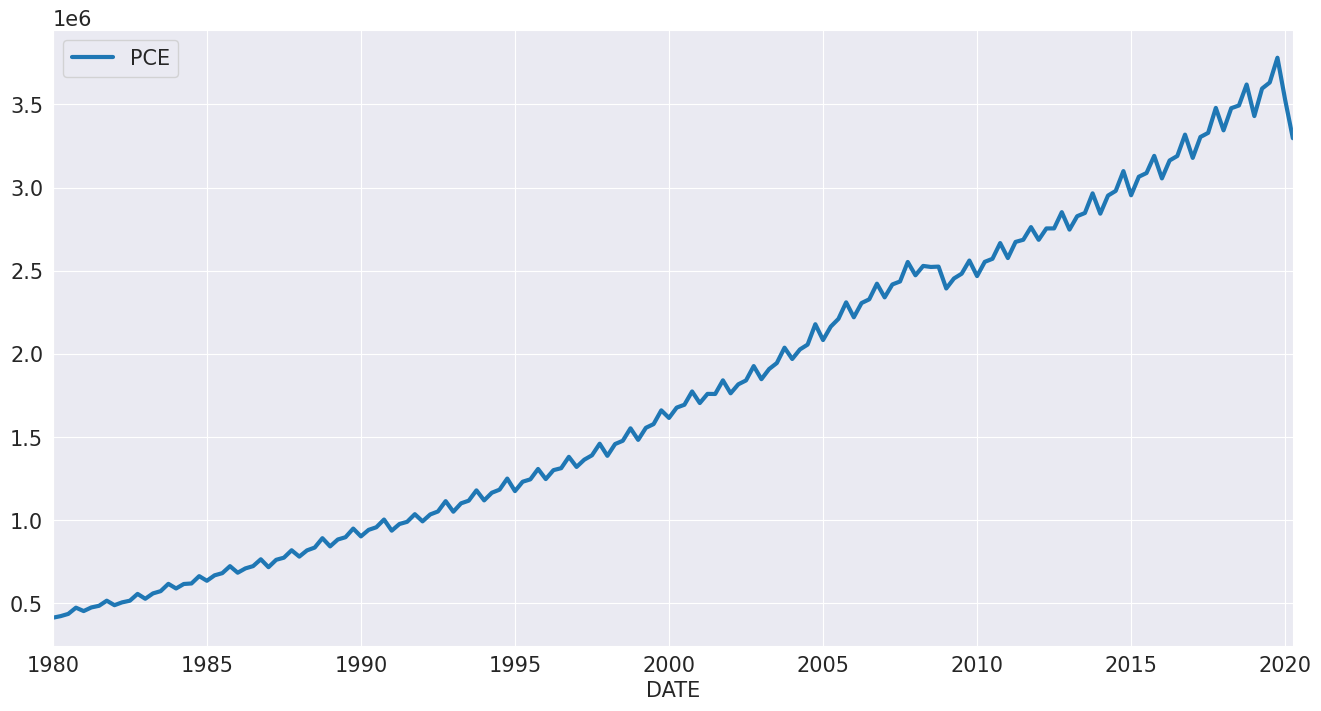
由于该系列始终为正,因此我们对 \(\ln\) 进行建模。
[8]:
mod = ThetaModel(np.log(pce))
res = mod.fit()
print(res.summary())
ThetaModel Results
==============================================================================
Dep. Variable: PCE No. Observations: 162
Method: OLS/SES Deseasonalized: True
Date: Thu, 03 Oct 2024 Deseas. Method: Multiplicative
Time: 15:46:32 Period: 4
Sample: 01-01-1980
- 04-01-2020
Parameter Estimates
==========================
Parameters
--------------------------
b0 0.013035370221488518
alpha 0.9998851279204637
--------------------------
接下来,我们探讨预测值随着 \(\theta\) 变化的差异。当 \(\theta\) 接近 1 时,漂移几乎不存在。随着 \(\theta\) 的增加,漂移变得更加明显。
[9]:
forecasts = pd.DataFrame(
{
"ln PCE": np.log(pce.PCE),
"theta=1.2": res.forecast(12, theta=1.2),
"theta=2": res.forecast(12),
"theta=3": res.forecast(12, theta=3),
"No damping": res.forecast(12, theta=np.inf),
}
)
_ = forecasts.tail(36).plot()
plt.title("Forecasts of ln PCE")
plt.tight_layout(pad=1.0)
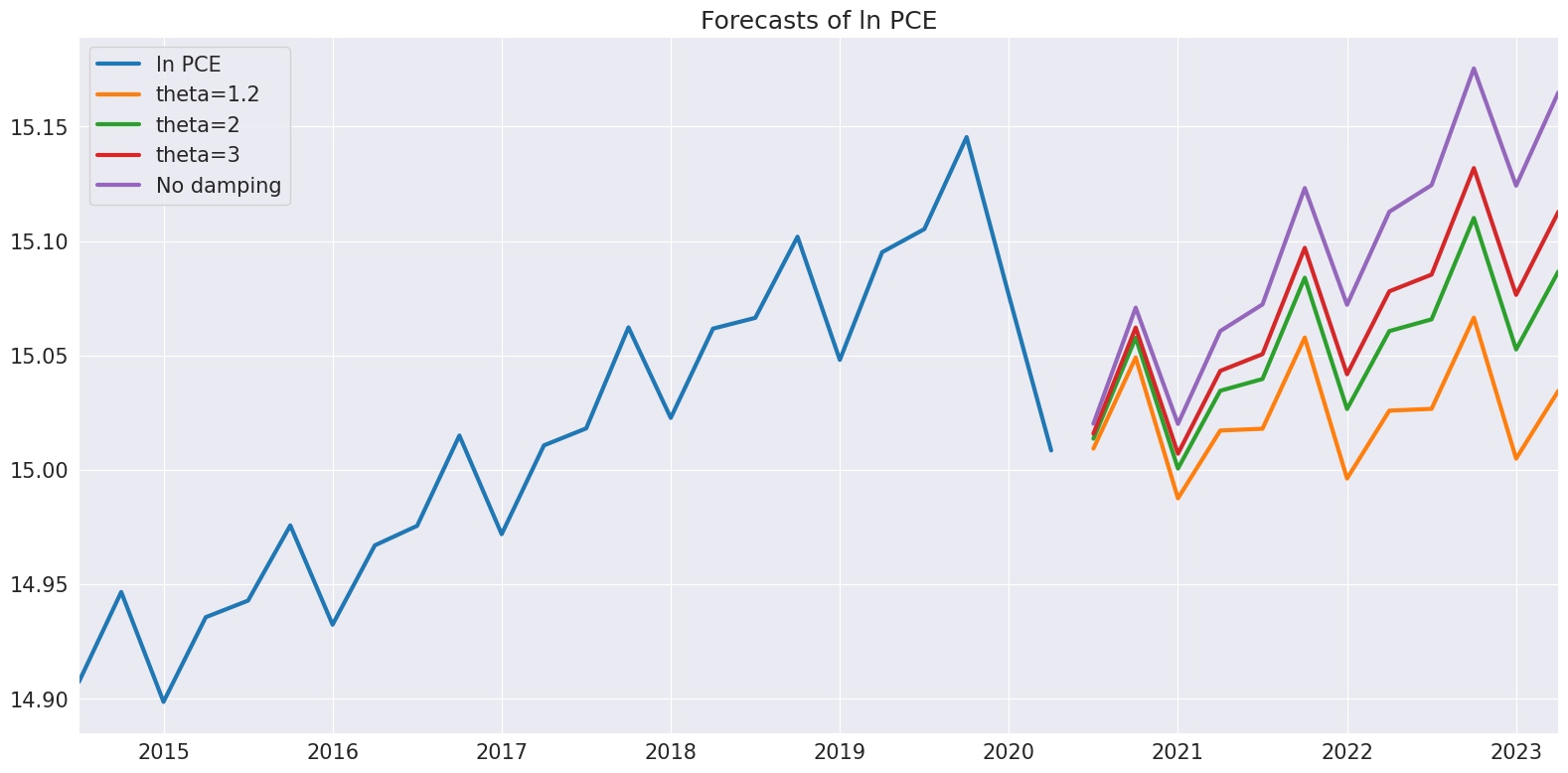
最后,plot_predict 可用于可视化预测和预测区间,这些区间是假设 IMA 为真而构建的。
[10]:
ax = res.plot_predict(24, theta=2)
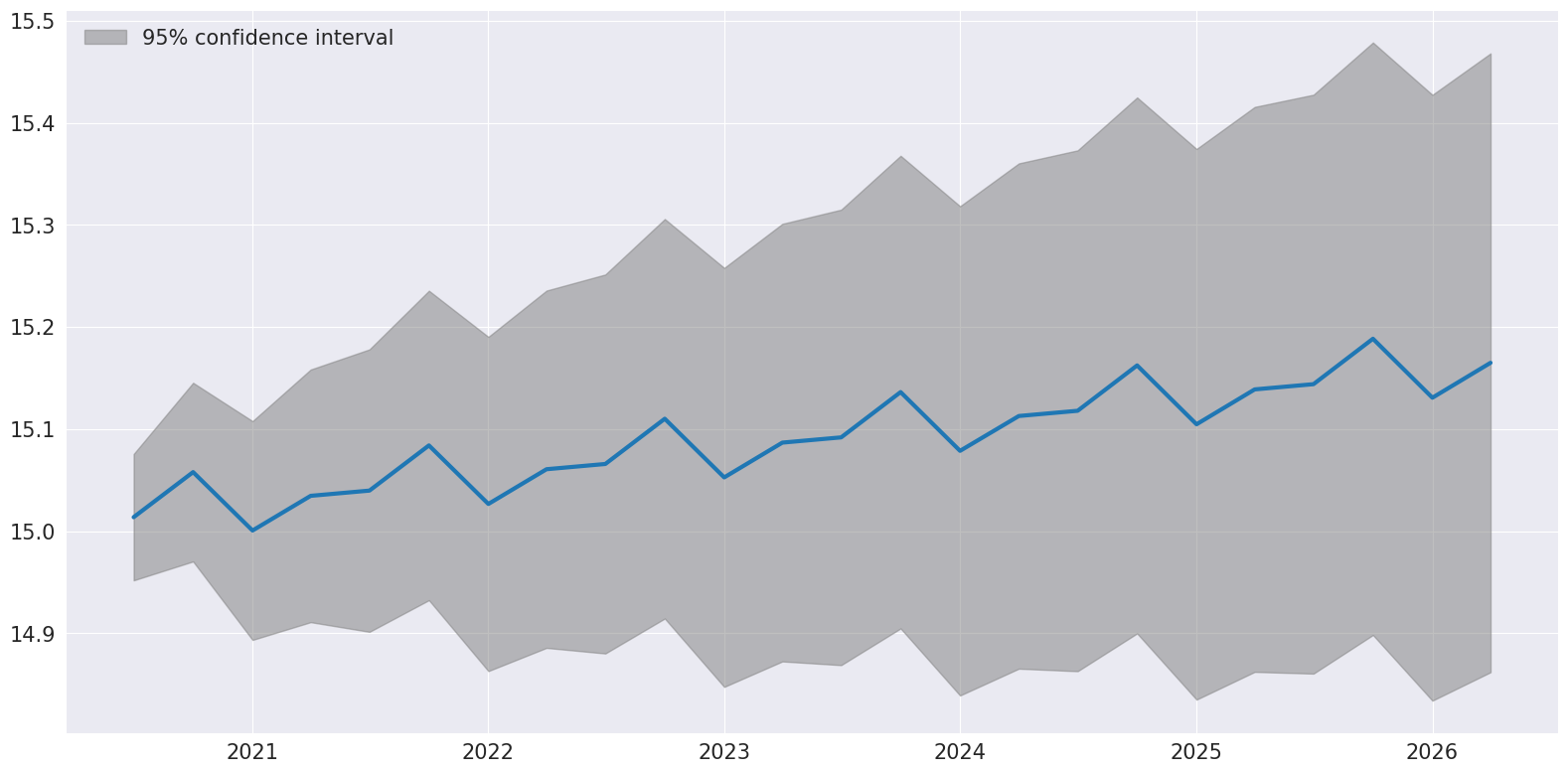
我们通过使用 2 年的非重叠样本生成刺猬图来结束。
[11]:
ln_pce = np.log(pce.PCE)
forecasts = {"ln PCE": ln_pce}
for year in range(1995, 2020, 3):
sub = ln_pce[: str(year)]
res = ThetaModel(sub).fit()
fcast = res.forecast(12)
forecasts[str(year)] = fcast
forecasts = pd.DataFrame(forecasts)
ax = forecasts["1995":].plot(legend=False)
children = ax.get_children()
children[0].set_linewidth(4)
children[0].set_alpha(0.3)
children[0].set_color("#000000")
ax.set_title("ln PCE")
plt.tight_layout(pad=1.0)
